Has Mt. Saint Helens Blown Again
(Volcanoes are not associated with atmospheric condition, merely instead are natural disasters.)
What is a volcano?
A volcano is a mountain that opens downward to a pool of molten rock below the surface of the earth. When pressure builds up, eruptions occur. Gases and rock shoot up through the opening and spill over or fill the air with lava fragments. Eruptions tin can crusade lateral blasts, lava flows, hot ash flows, mudslides, avalanches, falling ash and floods. Volcano eruptions have been known to knock down entire forests. An erupting volcano tin trigger tsunamis, flash floods, earthquakes, mudflows and rockfalls.
 Click Here to learn more about volcanoes from USGS. How are volcanoes formed?
Click Here to learn more about volcanoes from USGS. How are volcanoes formed? Volcanoes are formed when magma from within the Earth'due south upper pall works its manner to the surface. At the surface, it erupts to form lava flows and ash deposits. Over time as the volcano continues to erupt, it will get bigger and bigger.
What are the different stages of volcanoes?
Scientists have categorized volcanoes into three main categories: active, fallow, and extinct. An active volcano is one which has recently erupted and there is a possibility that it may erupt soon. A fallow volcano is ane which has not erupted in a long fourth dimension simply there is a possibility it can erupt in the future. An extinct volcano is one which has erupted thousands of years agone and there'south no possibility of eruption.
Why do volcanoes erupt?
The Earth's crust is made upwardly of huge slabs called plates, which fit together like a jigsaw puzzle. These plates sometimes move. The friction causes earthquakes and volcanic eruptions near the edges of the plates. The theory that explains this procedure is called plate tectonics.

What are plate tectonics?
The theory of plate tectonics is a interesting story of continents globe-trotting from place to identify breaking apart, colliding, and grinding confronting each other. The plate tectonic theory is supported past a wide range of bear witness that considers the earth's crust and upper pall to be composed of several large, sparse, relatively rigid plates that motility relative to 1 some other. The plates are all moving in dissimilar directions and at different speeds. Sometimes the plates crash together, pull apart or sideswipe each other. When this happens, it commonly results in earthquakes.
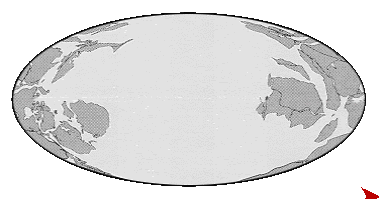 |
| Continental Drift: To see this animation again, but refresh this page! This animation shows yous what our planet looked like millions of years ago and what information technology looks like now! (Graphic Credit: Geology Department at University of California, Berkeley) |
Click Here to acquire more well-nigh plate tectonics and the globe-trotting of our continents. How many volcanoes are at that place?
There are more than 1500 active volcanoes on the Earth. Nosotros currently know of 80 or more which are nether the oceans. Active volcanoes in the U.South. are found mainly in Hawaii, Alaska, California, Oregon and Washington.
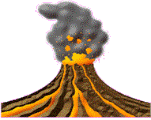
What are the different types of volcanoes?
Volcanoes are grouped into four types: cinder cones, blended volcanoes, shield volcanoes and lava volcanoes.
| Cinder Cones | Cinder cones are circular or oval cones made up of pocket-size fragments of lava from a unmarried vent that have been blown into the air, cooled and fallen around the vent. |
| Blended Volcanoes | Blended volcanoes are steep-sided volcanoes composed of many layers of volcanic rocks, usually made from loftier-viscosity lava, ash and stone debris. Mt. Rainier and Mountain St. Helens are examples of this type of volcano. |
| Shield Volcanoes | Shield volcanoes are volcanoes shaped like a bowl or shield in the middle with long gentle slopes fabricated by basaltic lava flows. Basalt lava flows from these volcanoes are called flood basalts. The volcanoes that formed the basalt of the Columbia Plateau were shield volcanoes. |
| Lava Volcanoes | Lava domes are formed when erupting lava is too thick to menses and makes a steep-sided mound as the lava piles up virtually the volcanic vent. The eruption of Mount St. Helens in 1980 was caused in part past a lava dome shifting to permit explosive gas and steam to escape from within the mount. |
What is the departure between lava and magma?
Magma is liquid rock inside a volcano. Lava is liquid rock (magma) that flows out of a volcano. Fresh lava glows red hot to white hot as information technology flows.

Why does lava accept a long time to absurd down?
Lava cools slowly considering lava is a poor conductor of estrus. Lava flows slow downwardly and thicken as they harden. What is a pyroclastic flow?
A pyroclastic flow is a fluidized mixture of solid to semi-solid fragments and hot, expanding gases that flows down the sides of a volcano. These awesome features are heavier-than-air emulsions that motion much similar a snowfall barrage, except that they are fiercely hot, comprise toxic gases, and move at astounding, hurricane-forcefulness speeds. They are the almost deadly of all volcanic phenomena.
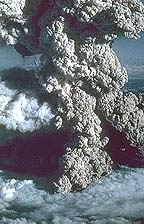
What is lahar?
A lahar is a type of mudflow or debris flow equanimous of pyroclastic material, rocky droppings, and water. The material flows down from a volcano, typically along a river valley. Information technology is very dangerous because it's consistency and the way it acts is very much like cement. It is liquid when information technology's moving, but when information technology stops, information technology solidifies. This tin crusade only equally much devastation as lava itself.
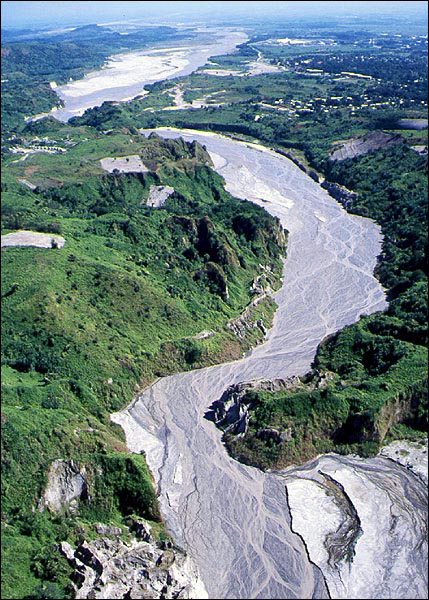
What is pumice?
Pumice is a lite, porous volcanic rock that forms during explosive eruptions. Information technology resembles a sponge because information technology consists of a network of gas bubbling frozen amidst frail volcanic drinking glass and minerals. All types of magma (basalt, andesite, dacite, and rhyolite) will form pumice.

What is the largest agile volcano?
The world's largest, active volcano is Mauna Loa in Hawaii, where famous java is grown in the rich volcanic soils. Mauna Loa is 13,677 feet above sea level. From its base of operations below sea level to its meridian, Mauna Loa is taller than Mount Everest.
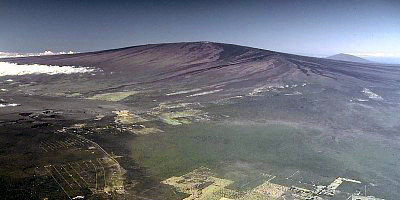
What is the Ring of Fire?
The Pacific Ring of Fire is an surface area of frequent earthquakes and volcanic eruptions encircling the basin of the Pacific Bounding main. The Ring of Burn has 452 volcanoes and is dwelling house to over 50% of the globe's active and dormant volcanoes. Ninety percent of the earth's earthquakes and 81% of the world's largest earthquakes occur along the Ring of Fire.
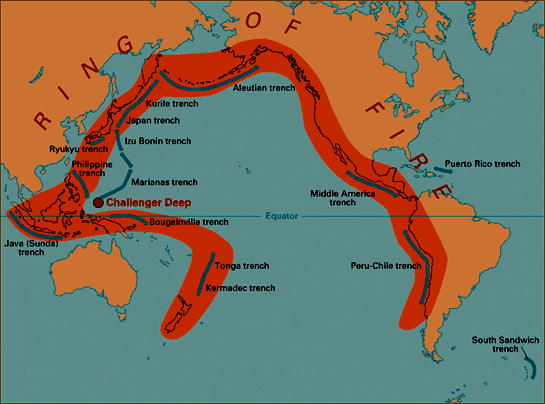
When did Mountain St. Helens erupt?
On May xviii, 1980, Mount St. Helens erupted. It'south located in southwestern Washington State in the Pour Range. The blast was heard every bit far away as Montana, Idaho, Canada and California. 50-vii people died and the eruption caused $1.2 billion in damage.
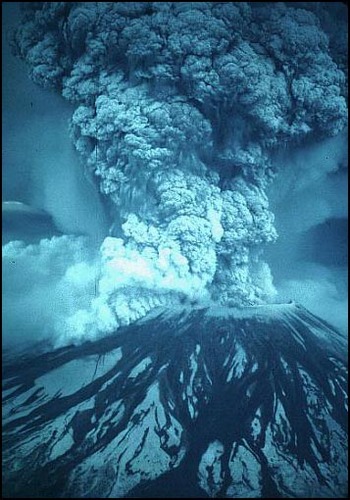
Click Here for more info on Mount St. Helens.
What are some other notable volcano eruptions?
Krakatoa was a dormant volcano in Republic of indonesia, which awakened and produced one of the biggest volcanic eruptions in 1883. So massive was the eruption that the audio of it was heard as far away as Commonwealth of australia. It's widely reported as the loudest sound heard in recorded history. The Krakatoa eruption created a huge amount of ash cloud which covered the Earth and reduced global temperatures for v years! A total of 40,000 people died in that explosion and an unabridged chain of the volcanic isle was destroyed. For more info: Click Here!
Mount Pelee was a dormant volcano situated in the Caribbean area island of Martinique. In 1902, it erupted in a massive horizontal explosion sending huge clouds of ash released towards the nearby boondocks of Saint-Pierre. The side of the volcano exploded and lava flowed straight into the town, killing xxx,000 people in a matter of minutes. It is regarded equally one of the biggest and most devastating volcanic eruptions of the 20th century, a criterion for time to come eruptions.
Mount Fujiyama, likewise popularly known as Mount Fuji, is an active volcano which concluding erupted in 1708. Information technology is incidentally the tallest mountain in Nihon. If you are visiting Tokyo, the capital of Nippon, wait in the west on a clear mean solar day and yous will exist able to meet Mount Fuji. It is an iconic volcano. Mount Fuji is 3,776 meters high and it is snow clad throughout the year, with five lakes surrounding it. Currently in a land of dormancy, at that place has not been whatever eruption reported for more than 300 years. The last known eruption lasted for almost three weeks during which information technology covered the surrounding villages with ash and cinders. Mount Fuji is now a popular tourist location with a large number of climbers actively scaling the mount acme.
What is a tsunami?
A tsunami is a large ocean wave usually caused by an underwater earthquake or a volcanic explosion. Tsunamis are Non tidal waves. Tidal waves are acquired by the forces of the moon, sun, and planets upon the tides, as well as the wind equally it moves over the h2o. With typical waves, h2o flows in circles, but with a tsunami, water flows straight. This is why tsunamis cause so much harm!
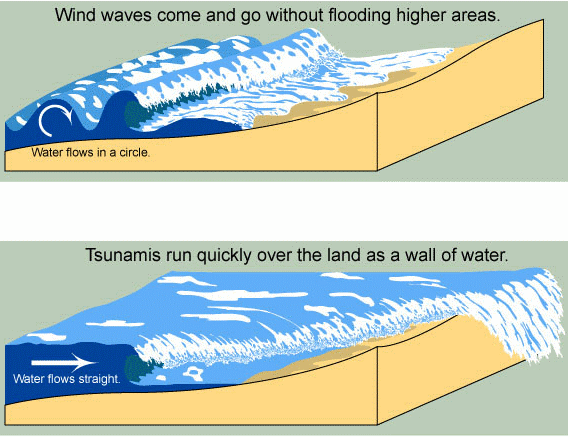
Click Here to meet an animation of an earthquake and the resulting tsunami. It'south nifty for kids, because they go to run across how information technology actually happens!
Click Here to get the latest tsunami alarm information from the NWS.
MAGMA - Magma is the liquid stone inside a volcano.
LAVA - Lava is the liquid rock (magma) that flows out of a volcano. Lava glows cherry-red hot to white hot as it flows.
Active VOLCANO - An active volcano is 1 that erupts regularly.
DORMANT VOLCANO - A fallow volcano is 1 that has non erupted for many years, although there is still some activity deep inside.
EXTINCT VOLCANO - An extinct volcano is a volcano that is no longer active.
GEYSERS - Geysers are springs that throw boiling h2o loftier in the air. They are acquired past volcanic heat warming trapped basis water.
ASH - Ash are very small fragments of lava or rock blasted into the air by volcanic explosions.
PUMICE - It is a light-colored volcanic rock containing lots of bubbles from trapped gases.
Click Here to see if in that location has been whatsoever contempo volcanic activity across the U.S.
PLAN FOR A VOLCANO: First of all, take a disaster plan and know whether or non you are at risk for danger. Exist prepared for mudslides, wink floods, earthquakes, ash falling, acid pelting and tsunamis. Prepare a disaster supplies kit for your dwelling and car. Include a offset aid kit, canned food and a can opener, bottled water, bombardment-operated radio, flashlight, protective clothing, grit mask, goggles and sturdy shoes. Don't forget, know all of your evacuation routes.
DURING A VOLCANO: Follow the evacuation order issued by authorities. Avert areas downwind and river valleys downstream of the volcano. If your caught indoors, close all windows and doors, put machinery inside a befouled, and bring animals inside. If you're trapped outdoors, seek shelter indoors. If you're caught in falling rocks, curl into a ball and protect your head. If you're caught near a stream, be enlightened of mudflows and move to college basis. Protect yourself when ash falls by wearing long-sleeved shirts and long pants. Use goggles to protect your eyes. Wear a grit mask and keep machine engines off.
AFTER A VOLCANO: Cover you mouth and nose. Volcanic ash tin irritate your respiratory system. Wear goggles and protect your optics. Go on your skin covered. Clear roofs of ash, because the ash is very heavy and can cause the edifice to collapse.
Lesson Plan: Here are neat lesson plans on learning more about volcanoes. These are bully lesson plans for elementary school students.
Volcano Experiment: Here is an experiment on how to make a soda bottle volcano with Mentos.
Volcano Experiment: Here is another experiment on how to make a blistering soda volcano.
Science Fair Projection Ideas: Hither is a complete list of science off-white project ideas. Find the science behind the conditions that impacts united states every day.
Source: https://www.weatherwizkids.com/weather-volcano.htm
0 Response to "Has Mt. Saint Helens Blown Again"
Post a Comment